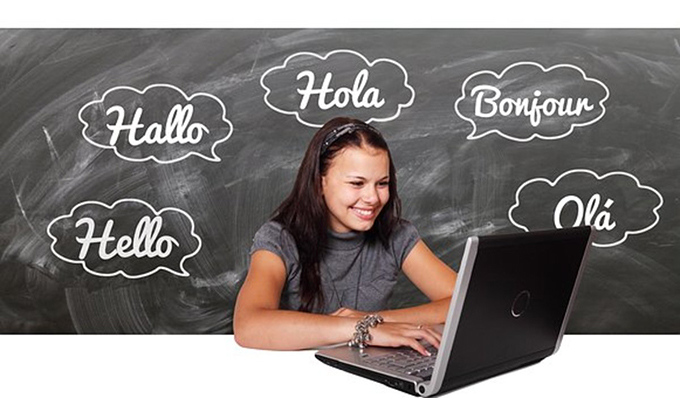
When was the last time you used another language? Perhaps it was to watch your favorite series, make a purchase or communicate on social networks? Let’s face it, in the 21st century the ability to communicate in other languages is increasingly necessary. In fact, knowledge of other languages is considered one of the basic skills that every person must have to live in a globalized world.
In the current context of global citizenship, learning foreign languages is crucial to interact with other cultures, for mobility and to increase training and employment opportunities.
Since 2000, the European Union has considered the acquisition of language skills a priority and promotes multilingualism, learning several languages, and interculturality as an element of union between peoples, cultures and countries.
In November 2017, the European Commission promoted the objective for 2025 of a “European Education Area” in which “speaking two languages, in addition to the mother tongue, is normal”. To achieve this goal, member states are adopting measures to promote the development of language skills at all educational levels.
The digital age and ubiquitous learning
In the digital age in which we are immersed, we find a multitude of digital tools available to learn or improve in almost any subject that interests us. Language learning has a wide range of digital resources ranging from applications to websites, multimedia resources and platforms for language learning.
Ubiquitous learning, that is, learning that occurs anytime, anywhere, transcends learning in formal and informal contexts. We can learn languages at our own pace, whenever and wherever we want, through our own mobile devices. This makes it a natural and ideal complement both to reinforce and perfect the learning of the languages we already know and to learn new ones.
Learn to learn
To make the most of digital resources you have to learn how to learn. It is not a one-time learning, but continuous, sustained over time. Skills and strategies are required that allow us to plan, organize, persist, reflect and self-assess our learning based on our own objectives.
Today, the issue is not so much the availability or access to resources, many of them free on the Internet, but managing these resources to put them at the service of what we want to learn. Hence the importance of developing the competence of learning to learn to promote learning that is increasingly autonomous, self-regulated and effective.
A free resource center
The University of Las Palmas de Gran Canaria (ULPGC) follows the guidelines of the Council of Europe for public institutions of Higher Education. Through its language policy, we promote training and ongoing development of communication skills in foreign languages in both formal and informal contexts.
One of the resources that the ULPGC puts at the service of society is the Resource Center for Autonomous Language Learning (CRAAL) . Born in 2018, this center has recently been updated through the award -winning educational innovation project Let’s use the CRAAL! Updating and dissemination of the Resource Center for Autonomous Learning of Foreign Languages of the ULPGC .
The CRAAL is a repository that has both bibliographic resources , located in different ULPGC libraries, and digital ones, through the web, which have been selected by teaching and research staff from the Faculty of Educational Sciences, the Faculty of Philology and the Faculty of Translation and Interpretation.
Materials for autonomous learning
CRAAL digital is a platform that catalogs and organizes the resources available on the network for multilingual learning, specifically, English, German, French and Spanish as a foreign language. The criteria that have guided the selection of these materials and resources are to facilitate autonomous learning and to be self-sufficient, that is, to contain all the necessary elements for self-learning.
The CRAAL website allows browsing through the cataloged resources, existing on the web, and applying various filters. The first is the selection of the language (English, German, French or Spanish as a foreign language) so that you can see a list with all the resources available for that language. It is possible to refine the search either by directly entering the name of the resource that you want to use or by applying other filters, separately or in combination. These filters include:
- Language level , according to the Common European Framework of Reference for Languages .
- Type of resource support: application, digital online, printed material.
- Skill or skill being worked on. For example, oral and listening comprehension, oral and listening production, grammar, vocabulary or interculturality.
- Type of activity: short dictations, creative writing or ordering sentences.
- Type of resource: online, dictionaries, radio/television, press.
Once the desired resource has been selected, simply click on the link to the resource to access it. Each resource has a tab that includes a brief description and characteristics of the resource based on the filters that can be applied, as well as a list of related resources.
Personalized itineraries
In addition, for members of the ULPGC university community, MiCRAAL allows each student’s learning itinerary to be personalized by keeping a record of the resources used. Simply identify yourself before accessing the Resource Center.
In an increasingly globalized world, language learning is a necessity to communicate, relate or simply work. The challenge of becoming multilingual speakers is demanding and requires effort and dedication. Fortunately, there is a variety of digital resources for language learning, including the CRAAL portal, which facilitate this task. You can learn languages how, when and where you want, at your own pace. There are no excuses, you just have to click.
Author Bio: Maria Esther Rodriguez Gil is Professor of the Department of Modern Philology, Translation and Interpreting at the University of Las Palmas de Gran Canaria
